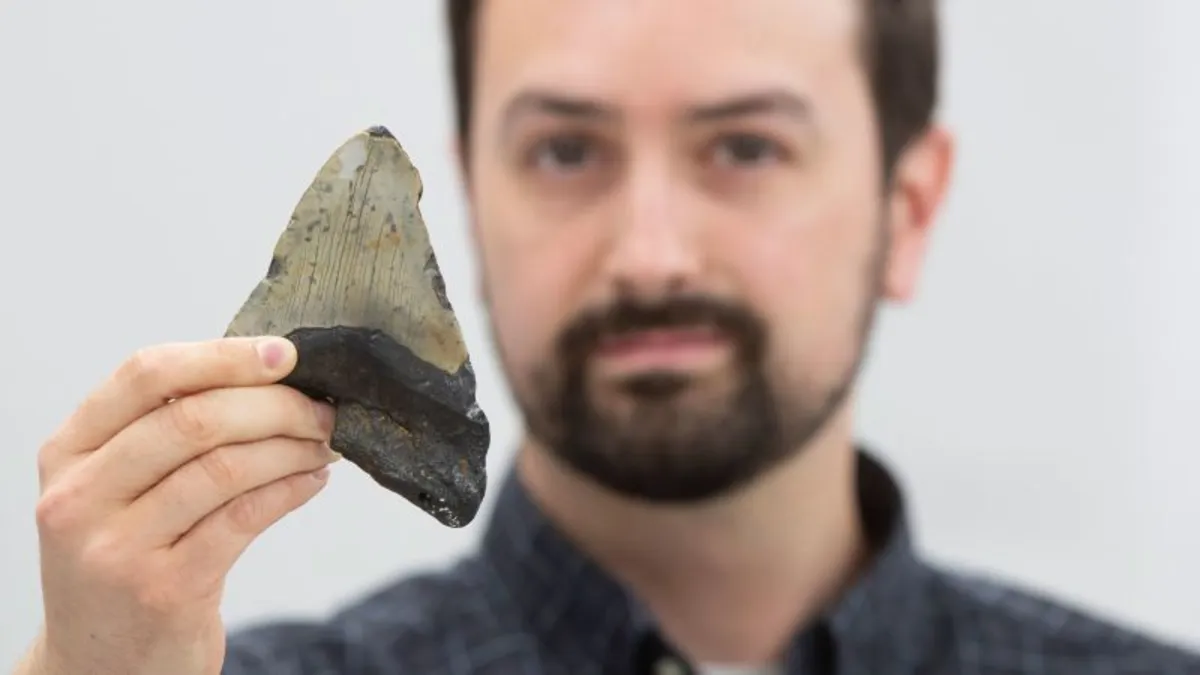
Sign up for CNN’s Wonder Theory science newsletter and explore the universe with news on fascinating discoveries and scientific advancements. Recent research is challenging long-held beliefs about the voracious feeding habits of the massive megalodon, a prehistoric predator that went extinct approximately 3.6 million years ago. Previously thought to primarily hunt large marine mammals like whales, a new study indicates that this ancient shark may have been a more flexible feeder than once believed.
The study, published in the journal Earth and Planetary Science Letters, reveals that the megalodon likely required an astonishing 100,000 calories per day to survive. Lead study author Jeremy McCormack, a geoscientist at Goethe University in Frankfurt, Germany, explained, “When available, it would probably have fed on large prey items, but when not available, it was flexible enough to feed also on smaller animals to fulfill its dietary requirements.” This suggests that megalodon was not just hunting big game but was opportunistic, adapting its diet based on local prey availability.
The research uncovered regional differences in the megalodon’s feeding habits, indicating that the giant shark would consume whatever was available in its environment. “They were not concentrating on certain prey types, but they must have fed throughout the food web, on many different species,” McCormack noted. This adaptability highlights the megalodon’s role as a fierce apex predator capable of tackling nearly any marine creature that swam in its vicinity.
Megalodon is known for its powerful bite and serrated teeth, which could reach up to 7 inches (18 centimeters) in length—comparable to a human hand. The abundant fossil record of megalodon teeth provided McCormack and his colleagues with the opportunity to conduct a geochemical analysis, unlocking new insights that could reshape our understanding of this ancient superpredator’s role in prehistoric ecosystems.
Despite previous studies that have questioned our understanding of the megalodon, many mysteries remain. The species name, Otodus megalodon, translates to “giant tooth,” yet no complete fossil has ever been discovered. This scarcity of evidence is partly due to the structure of fish skeletons, which are primarily made of softer cartilage rather than bone, making fossilization less likely. Recent research has suggested that the megalodon may have been more warm-blooded than modern sharks, and ongoing debates continue regarding its size and shape.
In 2022, scientists suggested a 3D reconstruction indicating that megalodon could reach lengths of about 52 feet (16 meters), while a March study proposed that this ancient shark could grow up to 80 feet (24 meters), surpassing even the fictional portrayal in the 2018 film The Meg. Determining megalodon’s diet using fossil evidence presents challenges, as McCormack explains, “Of course, you can see bite marks on the bones of marine mammals, but you will not see them if they fed on other sharks, because sharks don’t have bones.” This inherent bias complicates the fossil record.
To better understand megalodon’s diet, McCormack and his team analyzed fossilized teeth, comparing them with those of contemporary and extinct species. They utilized specimens from museum collections and beached animals to conduct a lab analysis of zinc, a crucial mineral acquired through food that plays an essential role in tooth development. The ratio of heavy and light zinc isotopes in tooth enamel can reveal dietary patterns, helping researchers trace megalodon’s place within the food chain.
The study revealed a complex dietary web, with sea bream, smaller sharks, and extinct toothed whales forming the lower levels of the food chain. Megalodon occupied a top position, but its zinc ratios indicated it may have also preyed upon lower-tier animals, showcasing its flexibility in feeding habits. McCormack stated, “Based on our new results, we see that it was clear it could feed at the very top, but it was flexible enough to feed also on lower levels of the food chain.”
Interestingly, the researchers found that megalodon was not the only apex predator of its time. It shared the top of the food chain with other opportunistic supercarnivores such as Otodus chubutensis and Araloselachus cuspidatus. This revelation contradicts assumptions that megalodon was the sole ruler of the ancient oceans, and it raises comparisons with the great white shark, another large opportunistic feeder. Paleobiologist Kenshu Shimada noted that the overlapping diets of megalodon and the great white shark might have contributed to the former’s extinction.
This new research allows scientists to reconstruct a snapshot of the marine food web that existed around 20 million years ago. Jack Cooper, a paleobiologist and megalodon expert, stated, “This study adds a new dimension that megalodon probably had a wide range of prey — essentially, it probably ate not just whales but whatever it wanted.” This flexibility in diet not only underscores the adaptability of the megalodon but also suggests that variations existed between different populations, similar to modern great white sharks.
As the study adds to a growing body of evidence reshaping our understanding of the megalodon and its relatives, researchers like Alberto Collareta emphasize the need to move beyond traditional reconstructions that likened megatooth sharks to “inflated” versions of modern sharks. “We now know that the Megalodon was something else — in terms of size, shape and ancestry, and of biology, too,” Collareta stated. The hope remains that further fossil discoveries will continue to illuminate the life of this ancient predator.